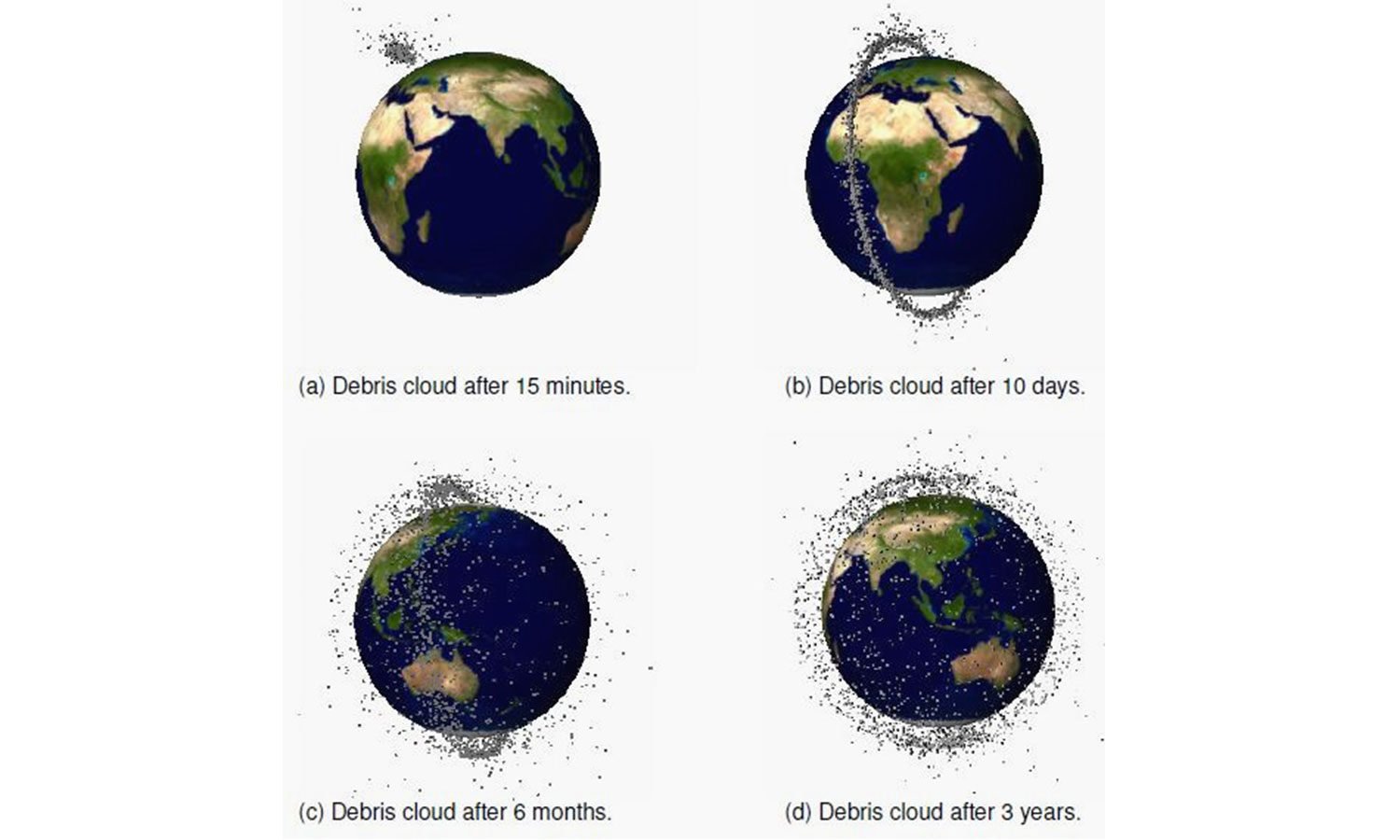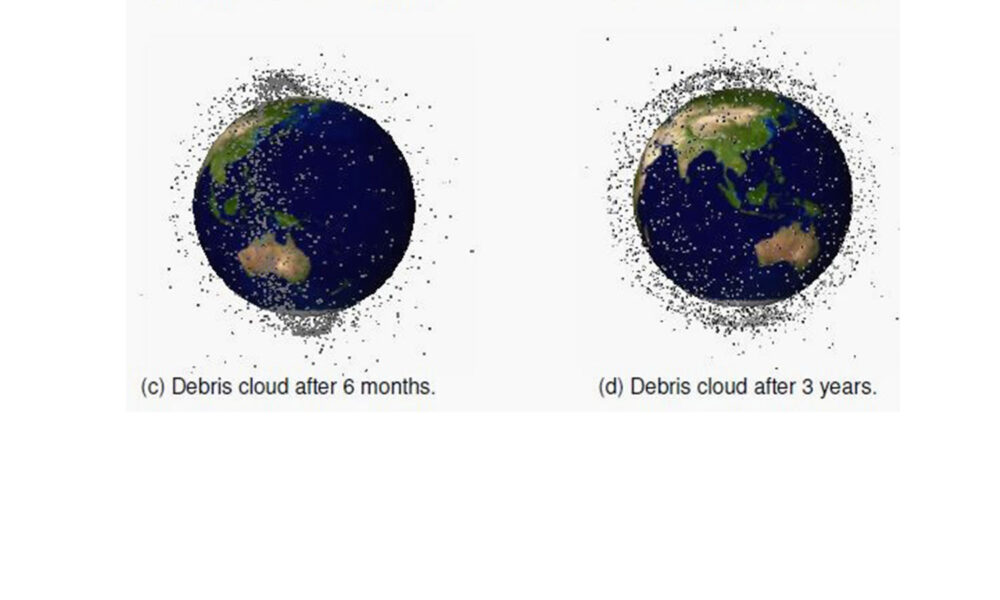Early Monday, the astronauts aboard the International Space Station had to take shelter in the transport vehicle while dangerous space debris passed close by. The debris was from Russia’s intentional destruction of a defunct satellite using an anti-satellite (ASAT) weapon launched from the ground. According the Pentagon, Russia did not provide advanced warning of the test.
This is not the first time a country has intentionally destroyed a satellite, though it is thankfully a rare occurrence. After a run of tests of anti-satellite weapons in the Cold War years, the US and the Soviet Union followed self-imposed moratoria on such tests, with the US leaving off after the destruction of the Solwind satellite in 1985 and the Soviets with their last test of a co-orbital anti-satellite weapon in 1982. China’s destruction of the Fengyun 1C satellite in 2007 broke this 22- year moratorium, and the US followed the next year by using a missile defense interceptor to destroy a failed satellite in 2008. India used similar technology to destroy one in 2019, at which point it declared that it had joined an “elite club of space powers.”
Russia could have chosen to do this test in a way that minimized dangerous debris, but instead destroyed a relatively large satellite at about 480 km, a high enough altitude to guarantee that some of the debris will stay in orbit for years. The satellite destroyed this week was the Cosmos 1408, which was reportedly about 2200 kg, 2.5 times heavier than the Fenguyn 1C satellite destroyed by China in 2007. That test generated about 40,000 pieces of debris large enough to damage satellites in a collision, though which are mostly too small to be reliably tracked.
The US Space Command has catalogued about 1500 trackable pieces of debris from the Cosmos 1408 destruction so far, though the full picture of the debris effects will probably take days or weeks to become clear. Cosmos 1408 was destroyed at an orbital altitude similar to that of the US Solwind satellite, and Solwind debris took a decade to clear out.
More than 600 active satellites, including the International Space Station, have orbits that pass through altitudes between 400 and 500 km putting them potentially in harms way of this debris. Satellites in these orbits journey around the earth every 90 minutes. Space debris created in a breakup doesn’t stay in one place, it evolves and spreads over time and some pieces of debris can be kicked up to much higher altitudes. (See the figure below which shows how debris from a satellite destruction will evolve over years.) This irresponsible action will make space riskier and more expensive for all users.

Wang Ting for Physics Today
Astronaut- and satellite-endangering debris is not the only issue. ASAT weapons risk sparking or exacerbating terrestrial crises in ways that may be difficult to predict or manage. It’s past time to address this unfolding arms race.
“I don’t want to get to get ahead of specific measures that we may pursue, that our partners and allies may pursue,” said US State Department spokesperson Ned Price, “but we are going to continue to make very clear that we won’t tolerate this kind of activity.” That’s encouraging, but the US has for decades resisted efforts to put meaningful constraints on anti-satellite weapons.
What might be done? Twelve years ago, we at UCS published the Securing the Skies report providing ten sensible steps the US should take to improve the security and sustainability of space, and unfortunately, most of them are still relevant and as-yet untaken.
The problems haven’t gotten any easier to solve. Anti-satellite weapons technology, including the direct ascent weapons demonstrated by Russia this week, is proliferating. While space-faring states are all cognizant of the danger posed by such weapons, they seem unprepared to forego them right now. One factor that significantly complicates this challenge is that the technology used for the recent attacks on satellites forms the core of US ground-based missile defenses against long-range nuclear-armed missiles. In fact, while nominally serving as US missile defenses, these systems constitute a large reservoir of ASAT capability. For their part, China and Russia are particularly threatened by the possibility that the US might pursue space-based missile defense systems and want to demonstrate the ability to negate such systems. These anti-satellite weapons are one way to do that. So the core security issues are thoroughly bound up in the issues of nuclear weapons and missile defenses, and these related issues will likely have to be addressed at the same time.
That will take a while. However, there are other ways to put in guardrails in the meantime. A first step: the UN could negotiate a ban on kinetic energy anti-satellite tests. I’m part of a group that has been calling on space-faring nations to pursue such a ban. Just weeks ago, on November 1, the UN General Assembly voted to establish an open-ended working group on “Reducing Space Threats through Norms, Rules and Principles of Responsible Behaviours,” which could be a venue for this discussion. Five countries voted against the establishment of the Group, among them Russia and China, ostensibly because Russia and China’s expressed preference is to work on these issues using legally-binding means, with the UN Conference on Disarmament as venue. But they may participate anyway.
As a first step, states could and should make unilateral declarations that they will not damage or destroy satellites. In fact, this was a core provision of the European Union-sponsored International Code of Conduct for Outer Space Activities, which tasked subscribing states to resolve not to do so except under exceptional circumstances. While that effort foundered in 2015, the United States had reviewed the Code and was prepared to conduct negotiations on it.
Unfortunately, if things go the way they have been, this test is more likely to bolster calls in the United States for new weapons to counter this “new” threat, rather than spurring arms control efforts. New weapons will do little to promote security but plenty to help an arms race along. Efforts to get a robust process to address space security issues have not met with much success, hence this drift into an environment with plenty of tensions and few guardrails. Is there anything different this time? Perhaps the audaciousness of this test, plus the enormous increase in commercial space activity investments, might be the key that finally turns this lock. Let’s hope so!

